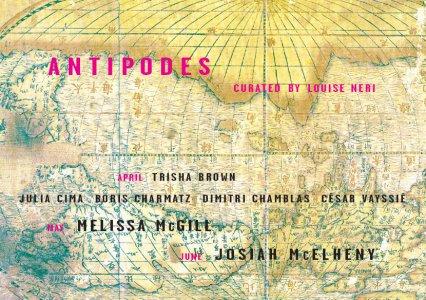Josiah McElheny
dal 3/6/2003 al 28/6/2003
Segnalato da
3/6/2003
Josiah McElheny
White Cube, London
The oeuvre of Josiah McElheny proposes, literally and conceptually, a keen reflection on the essence and limits of artistic creation, on the tensions between reconstructing and imagining history; between the fabricated and the appropriated object; the original and the copy; between architecture and the objects it contains; the notion of display and how it affects out viewing of an object and so on.

The oeuvre of Josiah McElheny proposes, literally and conceptually, a keen reflection on the essence and limits of artistic creation, on the tensions between reconstructing and imagining history; between the fabricated and the appropriated object; the original and the copy; between architecture and the objects it contains; the notion of display and how it affects out viewing of an object and so on. With his earlier glass recollections of objects linked to historical or literary episodes with explanatory texts in museological style, McElheny managed to build a bridge between tradition and modernity, while questioning the nature of the artistic object.
Gathering first-hand expertise and knowledge from different cultural quarters of the glass-making industry has assisted Josiah McElheny in developing a critical attitude to glassmaking, to work both inside and outside of his chosen idiom. An expert and erudite glassblower himself, McElheny deconstructs the industry not as a moralizing postmodern gesture, but rather for himself in order to inhabit other, more fertile identities that allow him to move freely between different zones of cultural knowledge and bodies of individual knowledge, to create new images and expanded meanings for the same world. A true "master of glass" in terms of his deep understanding of the literal and metaphorical potentials of his medium, he is an interloper, an extraterritorial, in every sense of the word.
His work with mirrors, for example, not only involves making objects to be physically apprehended, but equally the history of the mirror as object and the history of reflectivity, and how these interdependent histories have been affected over time by changing technical, aesthetic, philosophical and cultural attitudes, as he succinctly states: "Although mirrors are objects, we don't really perceive them as such; we tend to think of them only in terms of functionality, as reflecting surfaces fused to the wall, but historically, they were objects in themselves, important architectural features, windows onto other worlds. We take the perfection of the mirrored surface for granted now, but the mirror was a very different physical object at different points in history, and the reflection it created always related to how people saw themselves at any given time."
His earliest work on this subject, The History of Mirrors (1998) told the story of the technological development of the mirror, from the polished volcanic obsidian mirror or "dark glass" to the heavily decorated mirrors of the eighteenth century. This was followed by a work directly inspired by Borges's poetry and essays on the subject that discusses mirrors in both a Western and an Eastern sense, the former being an image of the self communicated through the science of optics, the latter being the glimpsing of the self in imperfect reflecting materials such as polished stone or wood. Borges's verse reveals that both genres of mirrors and their "uninhabitable, impossible space of reflection" disturb him in that their clarity or distortion show him "another Borges," separate from himself, unattainable. Possible Mirrors (2002) employed yet another scale and rhythm to explore the disturbing place of Borges's perception where images are formed, arrested and subjected to a process of ever-changing potentiality.
In his recent exhibition in New York Theories of Reflection, which made reference to a wide range of historical figures from seventeenth century polymath Anathasius Kircher twentieth century utopian Buckminster Fuller, McElheny spun his investigations into reflectivity out into dizzying new sculptural dimensions. Working entirely in blown mirror glass he created reflective objects designed to inspire reflection, a rhetorical construct that proposed contemplation as a function of physical effects. Buckminster Fuller's Proposal to Isamu Noguchi for the New Abstraction of Total Reflection materialized the imagined results of Buckminster Fuller's claim that Noguchi had invented a new shadowless abstraction of totally reflective objects. (Their original conversation happened in the late 1920's when Noguchi had just returned from apprenticeship with Brancusi where his job was to polish the sculptures to a reflective level beyond the human eye's ability to perceive); fittingly, McElheny's usual clear conceptual strategies turned into an enthralling visual labyrinth of order and chaos.
Continuing his exploration of how ideas become intertwined, informed and extended by their form in materiality, with Model for Total Reflective Abstraction (after Buckminster Fuller and Isamu Noguchi) McElheny has perhaps created the ultimate work of this series, a large floating plane or landscape of mirror upon which sits a landscape, model, or "garden" of his interpretations of Noguchi's sculptural forms in all materials, all rendered in totally reflective handmade glass. Importantly, this work departs from a true historical anecdote and reimagines, and thus heightens, the possible consequences of that narrative.
_______
Josiah McElheny studied at the Rhode Island School of Design. He trained extensively with master glassblowers in Europe and the U.S. His work was the subject of a survey exhibition at the Centro Galego Arte Contemporanea in Santiago di Compostela, Spain in 2002.
Inside the White Cube will be open from Tuesday through Saturday, 10am - 6pm, with changing exhibitions opening on the first Tuesday of every month.
For further information please contact Susannah Hyman or Honey Luard on 020 7930 5373. Inside the White Cube is generously presented in association with Dornbracht, the German manufacturer of high-quality design fittings, accessories and interiors.
Opening Wednesday 4 June 6-8pm
Inside the White Cube, 48 Hoxton Square, London N1 6PB



